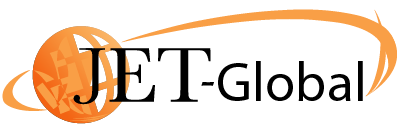Choosing the right 3D scanner is key to getting accurate scans that match your needs. After all, picking the right tool will always get the job done most efficiently. Without the right info, it can be tough to partner with the best company or manufacturer. This article dives into what 3D scanners are, their types, uses, needed gear, budget and cost and even compares top companies making them. If you’re thinking about using a 3D scanner or need help selecting the right one, we’ve got all bases covered!
目次
What is a 3D Scanner?

Let’s start by understanding what a 3D scanner is and explore the four types available. These scanners are amazing—they capture the world around us as digital data, using light or lasers to precisely recreate shapes and colors on a computer. They’re used everywhere from industry to entertainment to healthcare, constantly finding new ways to help, from designing products to preserving history!
The versatility of 3D scanners is mind-blowing. You can find 3D scanners everywhere from industry to entertainment to medicine, revolutionizing fields like product design, CG in movies, and preserving ancient artifacts.
There are also various scanner types, each tailored for different needs:
- Handy type: Portable, perfect for scanning on-the-go.
- Stand-alone type: Fixed and ideal for larger objects and structures.
- Desktop type: Super precise, meant for scanning smaller objects.
- Medical scanner: Specialized for digitizing patient body parts and medical gear.
The size of the object to be scanned ranges from small objects to objects the size of a room, but there are limitations when scanning very large buildings, and in such cases other types of scanners are recommended. In the next section, we’ll dig into the details of these scanner types, their characteristics, and how to choose one based on your application. Read on to find out which scanner is best for your business.
1. Handy Type:
Features: Portable, lightweight, easy to use, limited range.Uses: Scanning small objects, on-site scanning, reverse engineering, documentation, quality control, heritage preservation.
Examples: Handheld scanners, photogrammetry apps.
2. Stand-alone Type:
Features: Fixed, high accuracy, large scanning area.Uses: Scanning large objects and structures, construction, architecture, surveying, archaeology, cultural heritage preservation, automotive design.
Examples: Arm scanners, CMM scanners, long-range scanners.
3. Desktop Type:
Features: Super high accuracy, small scanning area.Uses: Scanning very small objects, precision prototypes, jewelry, dentistry, medical applications, electronics, quality control.
Examples: Desktop scanners, benchtop scanners.
4. Medical Scanner:
Features: Specialized technology for capturing human anatomy.Uses: Medical imaging, surgery planning, prosthetics, orthodontics, dental implants, patient monitoring, research.
Examples: CT scanners, MRI scanners, ultrasound scanners.
Now that we are familiar with the different types of 3D Scanners, let us take a deeper dive into understanding how these amazing machines work. If you have any questions about any of the devices mentioned in this article, please feel free to reach out to us with any inquires you may have. Without further ado, let’s begin.
How do 3D Scanners Work?
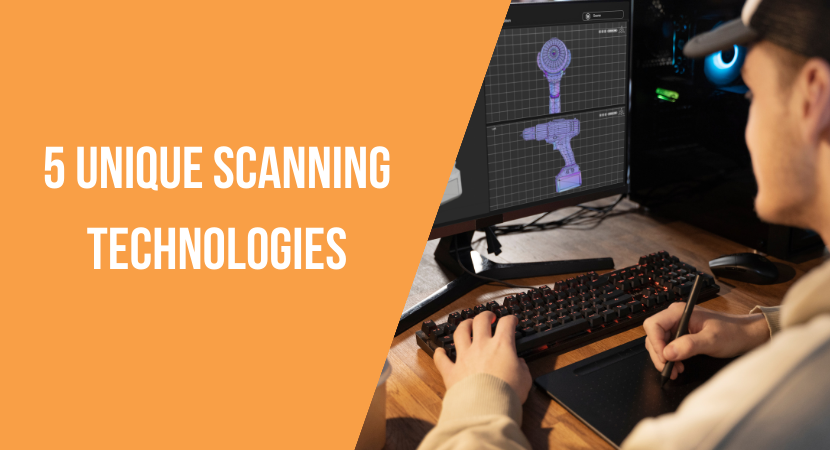
If we look at most applications of the technology, 3D Scanners can be broadly classified into two main types :
- Optical 3D Scanner
- Laser 3D Scanner
Optical 3D Scanner
Optical scanners can capture 3D data by analyzing the interaction of light with an object. They work through various methods, including projecting patterns, capturing stereo images, and using structured light, each offering unique advantages and disadvantages.Optical 3D Scanners use the following methods to capture the data they are studying :
- Pattern Light Projection Method
- Stereo Camera Method
- Structured Light Method
These methods of scanning have their own advantages and disadvantages and you may want to consider the factors that apply to your circumstances before investing in a 3D Scanner of your own! Let us take a look at the workings of some of these optical 3D scanners.
Pattern Light Projection Method
Works by projecting patterns of light onto the object and analyzing the deformation.Advantages: Fast, accurate, good for large areas.
Disadvantages: Sensitive to ambient light, may not work well on reflective surfaces.
Applications: Reverse engineering, inspection, quality control, 3D printing, cultural heritage preservation.
Stereo Camera Method:
Using two cameras to capture images from different angles and triangulating the object’s surface.Advantages: Affordable, simple to use.
Disadvantages: Less accurate than other methods, limited range.
Applications: 3D modeling, photogrammetry, robotics, augmented reality.
Structured Light Method
This method is similar to pattern light projection, but also uses a structured pattern (e.g., stripes) for more accurate analysis.Advantages: High accuracy, good for textured surfaces.
Disadvantages: Can be computationally expensive, slower than other methods.
Applications: Medical imaging, dentistry, facial scanning, 3D printing, product design.
These are the main methods of operation for optical 3D scanners. Optical 3D scanners offer a plethora of advantages when it comes to quickly analyzing various objects shapes and even pattern recognition when being combined with AI.
Laser 3D Scanner
Now, let us take a look at some of the methods of operation for laser scanners. Unlike Optical scanners, laser scanners are mainly used to measure the distance to various objects. They operate using various triangulation methods each offering distinct and unique data to provide insights and understanding. These laser scanners are known for their high accuracy and long range, making them ideal for large-scale projects like surveying, construction, archeology and even astronomy. Let us take a deeper look at some of these methods of operation and try to understand them better.Laser 3D Scanners use the following methods to capture the data they are studying :
- Time of Flight (ToF) Method
- Triangulation Method
Both of these methods have their own strengths and weaknesses. depending on the nature of your operation, you may want to consider the pros and cons of each method and decide for yourself which type of Laser 3D Scanner would be best for you. Now, let us take a look at some of the applications and benefits of these methods.
Time of Flight (ToF) Method:
It works by measuring the time it takes for a laser pulse to travel to the object and back.Advantages: Very fast, long range.
Disadvantages: Can be expensive, less accurate than other methods.
Applications: Surveying, construction, archaeology, architecture, forestry,astronomy, etc
Triangulation Method:
This method works by measuring the angle between a laser source, the object, and a camera to determine the object’s surface.Advantages: High accuracy, good for small objects.
Disadvantages: Slower than ToF method, limited range.
Applications: Reverse engineering, product design, quality control, 3D printing, medical imaging.
Since laser scanners are more expensive and a little slower than some Optical scanners, they do not see widespread use out of certain specific niche situations. However, that being said these scanners can be quite versatile and often the data collected to the use of these scanners have led to some of the biggest discoveries of mankind.
Applications of 3D Scanners
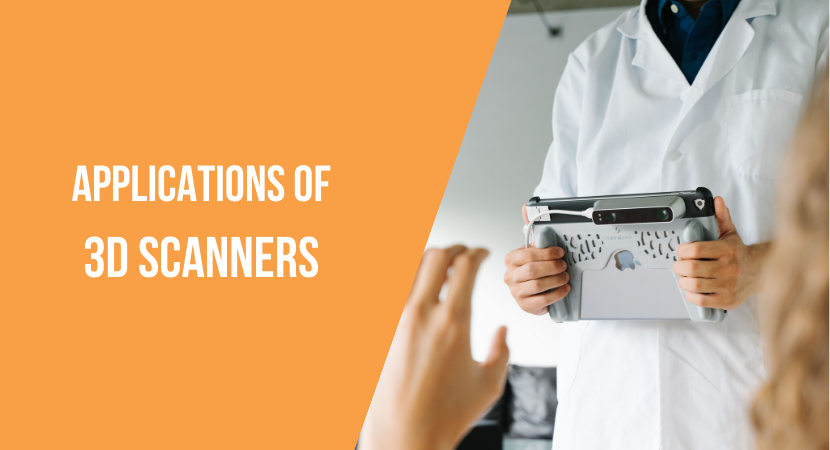
The effects of 3D scanners can be felt throughout modern industry, manufacturing and design. 3D scanning technology has been constantly improving and increasing its value by demonstrating proficiency in reproducing physical objects as digital data that can be further studied in detail.
To understand the widespread importance of the use of 3D scanners in modern society, let us now take a look at some of the major uses and applications of 3D scanners.
1. Reverse Engineering
In this situation, 3D scanners are used to create digital modules of existing objects. This allows the scanned object to be analyzed and understood by a computer that can then suggest methods to replicate their design. This makes 3D scanners invaluable in product development, repair and customization.Specifically, reverse engineering of the following materials and products is often carried out.
Metals: Machine parts and industrial products.
Plastics: Various consumer goods and components
Ceramics: Certain industrial parts and artwork
Wood: Analysis of existing furniture and decorations
Rock formations and bones: Archaeological finds and fossils
2. Inspection
3D scanners are also used for non-destructive inspection of manufactured parts and other structures. This allows it to be used for various quality control and safety operations. 3D scanners can provide accurate data and visualization for even complex machinery, thus enabling efficient defect detection and prevention.Inspection using 3D scanning technology has greatly contributed to improving product quality and optimizing production efficiency through its advanced data acquisition and analysis capabilities, and its value is expected to continue to increase in the future.
3. Surveying
When it comes to surveying, 3D scanners are some of the most widely used in the industry. This is because 3D scanners can capture detailed representations of land buildings and infrastructure. This data is vital for planning and construction, monitoring various environmental factors, analyzing biomes and even disaster response.Specifically, surveying is carried out in the following industries and situations.
Building industry: For gathering foundational data when designing new buildings or renovating or repairing existing buildings.
Civil engineering: For planning and designing infrastructure construction and renovation such as roads, bridges, and dams.
Mining: For mining planning and safety confirmation.
Archeology: For 3D modeling and conservation of ancient ruins and historical sites.
4. CG Creation
Our favorite movies and video games would not be possible if it were not for advancements in 3D scanning technology. Animation, rigging and body tracking all rely on 3D scanning technology in today’s world to reduce processing time and to increase quality of output. This revolutionizes storytelling design and training.Specifically, 3D scanning surveying technology is used in the following industries and situations.
Gaming IndustryUsed for 3D modeling of video game characters, items, and backgrounds based on real-world objects and locations. For example, in a realistic racing game, real cars and circuits are scanned and recreated in the game.
Film and Television IndustryUsed in the production of special effects and CG scenes where realistic 3D data of backgrounds and objects is required. For example, it can be useful for realistically depicting large-scale battle scenes or fantasy worlds.
Virtual Reality (VR) & Augmented Reality (AR): Used to create 3D content linked to the real world. For example, when creating AR guides for museums and tourist destinations, or VR experience content, real locations and exhibits are scanned and recreated as digital content.
Digital Art: Used in art and design to create 3D artwork based on real objects. An example would be a 3D reproduction of an artwork such as a sculpture or installation that is displayed in a digital gallery.
5. Digital Archive
Humanity has always wanted to preserve history. 3D scanners help us do this better than ever before. 3D scanners can preserve high quality data of various historical artifacts, cultural objects and endangered species in a digital format. This ensures that no matter how much time passes, these preserved specimens are accessible to future generations.These are just some of the ways in which 3D scanners are Transforming Our World and everyday modern society. With time, their applications will continue to expand and impact diverse fields like healthcare, education,robotics and more.
So far, we have introduced the various specific uses and industry applications of 3D scanners. In this next section, we will take a quick look at some of the advantages and disadvantages of 3D scanners. A clear understanding of which of these factors May apply to your unique needs is important when choosing the perfect 3D scanner.
3D Scanner Advantages and Disadvantages
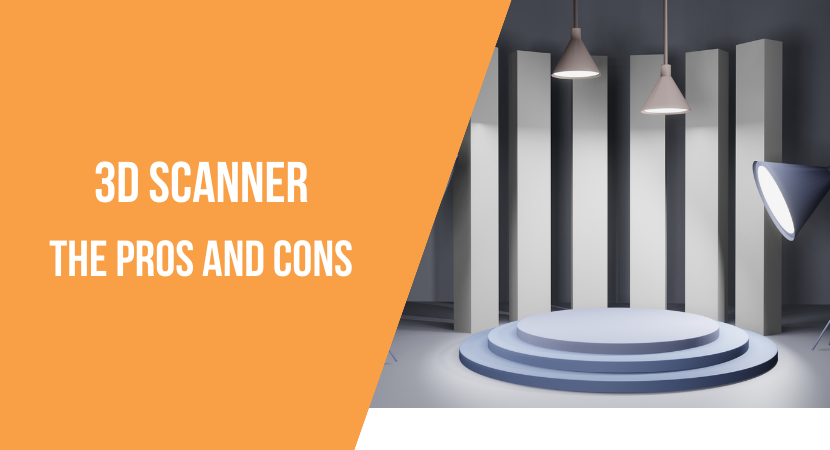
3D scanning technology has revolutionized various industries and research fields, capturing objects and environments with high precision. However, understanding its pros and cons is crucial before investing.
3D Scanner Benefits
1. Ease of Handling
No physical contact with objects, ideal for sensitive items and historical artifacts.Precise measurements without harming objects, perfect for engine components or historic building replicas.
Streamlines tasks like detailed analysis and object recreation.
2. Real-time Feedback
Instant data acquisition and feedback for efficient scanning and quality control.Quick identification and correction of errors during scanning, increasing efficiency.
Valuable for scanning delicate objects or in precision-demanding industries.
3. Color Information Acquisition
Enables realistic reproduction of objects for reverse engineering or online displays.Enhances fidelity in situations like digitizing historical artifacts, CG production, and product design prototyping.
Provides detailed insights into the original condition of objects or realistic feedback on new designs.
Disadvantages
1. Internal Structure Limitation
3D scanners only capture external shapes, not internal structures.LiDAR and ultrasonic sensors are better suited for internal inspection tasks.
2. Large Area Scanning Constraints
Many 3D scanners are designed for detailed capture of small objects or specific areas.Battery life, data processing power, and scanning range limit large-scale geographic scanning.
Not ideal for mapping extensive terrains or surveying large infrastructures.
3. Scanning Challenges under Certain Conditions
Bright environments: Strong external light sources interfere with data accuracy.Transparent or reflective objects: Light-based scanning struggles with these materials.
Consider scanning during low-light conditions or applying alternative materials for optimal results.
Carefully considering these factors and your specific application will help you determine whether a 3D scanner is the right investment for you.
Now that we are all caught up, it’s time to look at how we can pick the best 3D scanner for the job. Once again, if you have any questions about any of the points mentioned in this article or need help with selecting a 3D scanner for your project or business, please do not hesitate to reach out to us with an inquiry.
Picking the Perfect Scanner
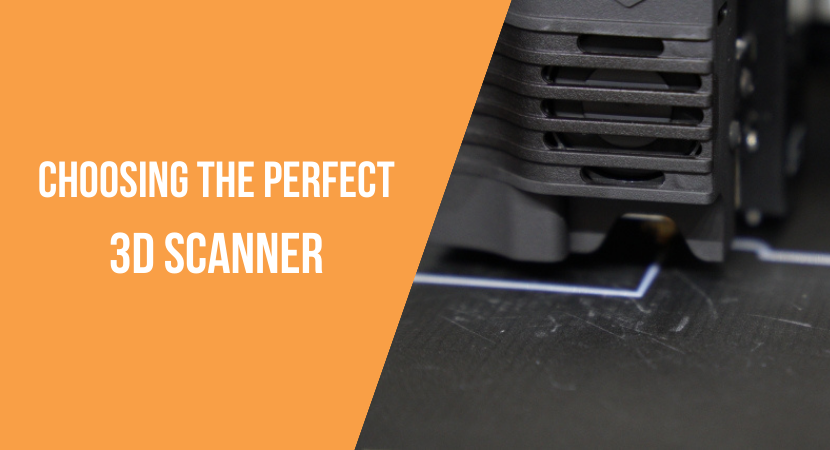
If this is your first time purchasing a 3D scanner, it can be daunting. We understand and we are here to help. Please keep reading further to understand how to choose the perfect 3D scanner for your needs. Consider the following factors to make a well informed choice when choosing a 3D scanner.
Application: What will you use the 3D data for?
Object Size: How large is the object you need to scan?
Accuracy Requirements: How precise does the scan need to be?
Budget: How much are you willing to invest?
Ease of Use: How comfortable are you with technology?
Portability: Will you be scanning in different locations?
Depending on your answers to these factors, the type of 3D scanner that you use can vary. In addition to this, it is also worth considering the advantages and disadvantages of the various scanners available at your disposal.
With 3D scanners being so diverse in their various applications, we can be spoiled for choice or even confused when picking one for ourselves.But worry not, our guide outlines a 5-step roadmap to help you navigate the selection process.
Step 1: Define Your Purpose
Identify your intended application for 3D scanning. This will guide your technology, scanner type, and budget decisions.Examples:
3D modeling for prototyping and hobbies (handheld/desktop scanner, triangulation method)
Surveying buildings and large-scale terrain (industrial scanner, ToF method)
Medical applications (medical scanner, structured light/patterned light projection)
Digitizing historical objects (handheld scanner, triangulation method)
Quality inspection (industrial scanner, pattern light projection)
Step 2: Determine Accuracy Requirements
Specify the required level of accuracy and resolution based on your application.Examples:
Reverse engineering: Needs high precision for capturing complex shapes and minute details (0.05mm resolution, ±0.01mm error range)
Architectural/civil engineering: Faster scan speeds are prioritized, while accuracy needs are moderate (100m+ scan distance, ±5mm error range)
Cultural property digitization: High precision and color information acquisition are crucial (0.1mm resolution, color acquisition capabilities)
Product quality inspection: Accuracy in dimensional measurement is key (0.05mm resolution, ±0.01mm error range)
Step 3: Consider Object Size
Choose the type of scanner based on the size of the object you need to scan.Examples:
Small artworks/artifacts: Desktop scanner with high precision for capturing fine details (300mm x 300mm x 300mm scan range, patterned light projection method)
Buildings/civil engineering structures: ToF scanner for quick large-area scanning (100m+ scan distance) Reverse engineering of cars/machinery: Triangulation scanner for high-precision scanning of large objects (5m x 5m x 5m scan range)
Step 4: Evaluate the Usage Environment
Select a scanner suitable for the environmental conditions where it will be used.Examples:
Outdoor topographic surveys: Requires scanner resistance to direct sunlight and temperature fluctuations (ToF method, industrial scanner)
Factory/production line inspection: Consider lighting conditions and interference from machinery (handheld scanner, triangulation/pattern light projection)
Scanning cultural assets: Assess lighting and surrounding environment (desktop/handheld scanner, structured light/stereo camera method)
Step 5: Set a Budget
Allocate a budget that aligns with your scanner needs and desired performance.By carefully considering these five steps, you can effectively select the optimal 3D scanner that matches your specific application, object size, environmental conditions, and budget. This investment can unlock the full potential of 3D scanning technology and help boost your project and business to new heights!
3D Scanner Cost : Matching Your Needs with Your Wallet
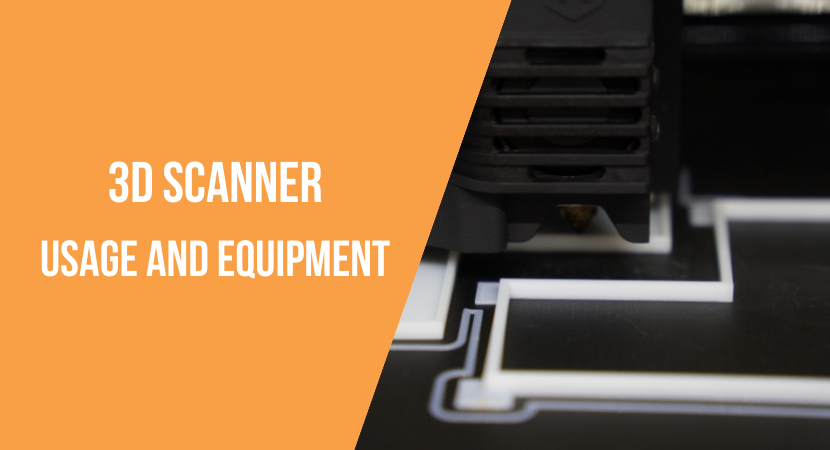
Preparing a well thought out budget for your ideal 3D scanner is the final step in your selection journey.
While cost is crucial, please remember that investing in a scanner that doesn’t meet your goals will ultimately be a waste of resources. Keep reading and we will try to help you invest in the machine that will be the best suited for your purposes.
Let’s start off by considering some budget factors and guidelines for using these 3D scanners.
Budget Factors
Purchase cost: This includes the initial investment in the 3D scanner itself.Operating costs: Consider ongoing expenses like maintenance, software licenses, consumables, and other operational necessities.
Rental options: For temporary projects, renting a scanner might be a more budget-friendly solution.
Budget Guidelines for Common Applications
Prototype manufacturing and hobbies
Budget: LowTechnology: Triangulation or structured light
Type: Handheld scanner
Criteria: Prioritize equipment with sufficient accuracy and functionality within your budget.
Medical applications (orthodontics, prosthetics)
Budget: Medium to highTechnology: Pattern light projection or triangulation
Type: Medical scanner
Criteria: Select equipment with high accuracy and safety features.
Industrial applications (construction, civil engineering)
Budget: HighTechnology: ToF method
Type: Industrial scanner
Criteria: Choose equipment capable of large-scale and long-distance scans.
Budget-Conscious Choices
Remember to compare prices from various suppliersDepending on the quality, consider refurbished or second-hand scanner options
Opting for open-source software solutions
Utilize free online resources for tutorials and support.
Did you get all that? It’s a lot to take in, I know. A 3D scanner can Empower your projects and raise them to new heights, but it’s essential to keep a strong balance between your budget and your own specific needs and desired features. consider all of the factors that we have mentioned above so that you can make a well-informed decision that helps not only maximize your investment but also unlocks the full potential of 3D scanning technology.
The Best 3D Scanner Manufacturers
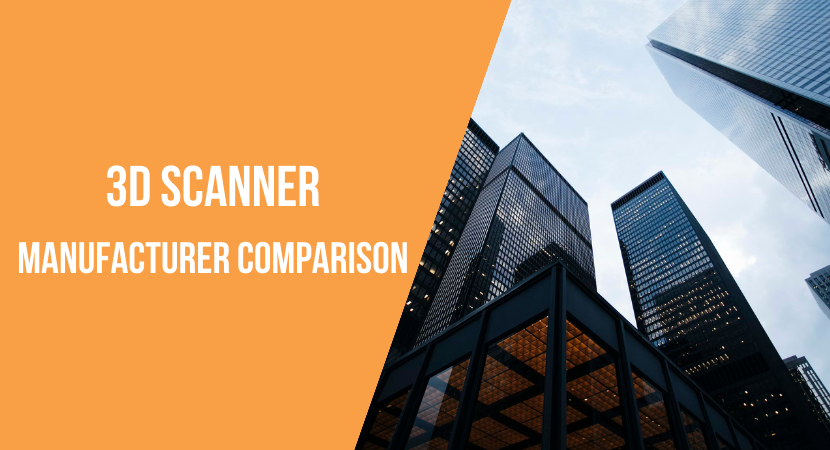
In the next section, we will introduce some 3D scanner manufacturers who are at the top of their game in their respective fields. If you want to find the best 3D scanner manufacturers, read on!
| Nikon | FARO | Hexagon | Scan Tech | Revpoint | |
|---|---|---|---|---|---|
| Surveying/Measurement | ✓ | ||||
| Construction/Civil Engineering | ✓ | ||||
| Accident/Crime Scene Investigation | ✓ | ✓ | |||
| Design, Layout and Projection | ✓ | ✓ | |||
| Failure/Diagnostics | ✓ | ✓ | |||
| Historical Preservation | ✓ | ||||
| Engineering | ✓ | ✓ | |||
| Production/ Manufacturing | ✓ | ✓ | |||
| Quality Control/ Inspection | ✓ | ||||
| Handicap | ✓ | ||||
| Desktop | ✓ | ✓ | ✓ | ||
| Medical Use | ✓ |
These five companies are well known in the industry for being Pioneers in their own respective fields. Let us now take a deeper dive into understanding the history behind these companies and how they are constantly pushing the boundaries of their own proprietary technologies.
1. Nikon
Japan’s optical giant, Nikon, etched its name into 3D scanning history in 1987 with the release of the world’s first industrial 3D scanner, the “Nikon 3D Measurement System.” Since then, they have consistently released high-performance scanners like the “LC15D” and “L100,” staying at the forefront of innovation.Their partnership with Trimble in 2016 further solidified their position. Nikon’s scanners excel in architecture/civil engineering and construction/equipment, enabling precise on-site measurements.
Known for:
LC15D: Designed for demanding industrial environments, the LC15D was built to withstand heavy use and harsh conditions.It is widely used in various industries, including automotive, aerospace, and manufacturing, for tasks such as reverse engineering, quality control, and inspection.
L100: The L100 offers high-speed scanning capabilities and an intuitive interface, making it easier for users of all experience levels to capture accurate 3D data. Its compact and portable design allowed for greater flexibility in scanning objects of various sizes and in different environments.
2. FARO
Born in the USA in 1982, FARO’s name reflects their mission to explore new horizons in 3D measurement. Their impact began with the world’s first 3D laser scanner, the “FARO Arm 3-D,” launched in 1986. Their technological prowess continued with the release of the “Focus S” stereo camera scanner in the 2000s, followed by the portable “Focus XT” in 2010. The acquisition of 3D Systems in 2016 further solidified their leadership. FARO’s diverse scanners, ranging from handheld to desktop types, find applications in various fields, from accident investigation to quality control.Known For :
Strength: Long-range scanners, laser scanning solutions, construction documentation.
Known for: Focus Laser Scanner series, Freestyle 3D handheld scanner.
Ideal for: Large-scale surveying, architecture, civil engineering, infrastructure management, BIM modeling.
3. Hexagon
A Swedish pioneer in 3D technology, Hexagon has been shaping the landscape since 1979. Their groundbreaking “Scan 3000” 3D laser scanner in 1984 revolutionized the field. The 21st century saw the release of their advanced ToF scanner, “SICK S3200,” setting new standards. Their acquisition of Nikon’s 3D scanner business in 2016 solidified their global leadership. Hexagon’s scanners cater to diverse needs, from engineering and manufacturing to quality control. Their desktop scanners are particularly popular for their ease of use and high accuracy.Known For :
SCAN 3000 : The Scan 3000 was one of the first commercially available 3D laser scanners, marking a significant shift from traditional measurement methods. It revolutionized industries such as construction, engineering, and shipbuilding by providing faster and more accurate data collection for tasks like surveying, design, and inspection.
SiCK S32000 : The SICK S3200 employed innovative Time-of-Flight (ToF) technology, enabling faster and more efficient scanning of large objects and areas.The S3200 opened doors to new applications in fields like mining, forestry, and archaeology, due to its ability to capture data of large and complex environments.
4. Scantech
Headquartered in Shenzhen, China, Scantech has emerged as a force in 3D scanning technology since its founding in 1999. Their achievements include releasing the world’s first 3D scanner in 2006, followed by successful innovations like the portable “SIMSCAN-3D” in 2010 and the high-precision “SIMSCAN-3D PRO” in 2015. Scantech continuously evolves its product lineup, catering to a wide range of applications, including accident investigation, design, manufacturing, and even medical care.Known For :
Strength: Color 3D scanners, high-resolution scanning, fast acquisition speed.
Known for: iReal 2, iReal M3, iReal Mini scanners.
Ideal for: Cultural heritage preservation, product design, quality control, reverse engineering, education.
5. Revopoint:
A young yet impactful player, Revopoint has rapidly gained recognition in the 3D scanning industry since its 2015 inception in Shenzhen, China. Their world-renowned 3D scanner released the following year quickly established their presence. The small and lightweight “revopoint POP” (2017) and the affordable “revopoint MINI” (2019) further solidified their reputation. Despite their young age, Revopoint offers a diverse scanner portfolio for design, manufacturing, and other applications. Their technology and affordability have found favor in various industries.Known For:
revopoint POP : The POP’s small and user-friendly design makes it ideal for hobbyists and casual users, offering an easy introduction to 3D scanning technology. Revopoint prioritized accessibility by making the POP significantly more affordable than competing scanners, opening doors to a wider audience.
revopoint MINI : Leveraging cutting-edge ToF technology, the MINI delivers high-resolution 3D scans with exceptional speed and accuracy.The MINI’s portability unlocks new possibilities for 3D scanning, enabling users to capture data in previously inaccessible locations, such as historical sites or nature scenes.
Noteworthy Manufacturers
Artec 3D
Strength: Handheld and professional scanners, high accuracy, user-friendly software.Known for: Eva, Leo, Spider, Space Spider scanners.
Ideal for: Reverse engineering, product design, quality control, cultural heritage preservation, healthcare.
Creaform
Strength: Industrial scanners, metrology-grade accuracy, large scan volumes.Known for: HandySCAN 3D, MetraSCAN 3D, Go!SCAN SPARK scanners.
Ideal for: Automotive, aerospace, shipbuilding, construction, inspection, research & development.
Shining 3D
Strength: Affordable desktop and handheld scanners, user-friendly interface, 3D printing integration.Known for: EinScan Pro 2X, EinScan H, EinScan SP scanners.
Ideal for: 3D printing, education, design, healthcare, small businesses.
These manufacturers are all pioneers in their own respective fields and technologies. With the breakdowns and explanations we have provided, you can now make a well-informed decision on what 3D scanner would be best suited for your project or business.
We hope our comprehensive guide on picking the best 3D scanner has helped you in your search. Please do feel free to browse our website to see other related machinery and feel free to engage with us on any questions you may have. We would be happy to help!
Contact us today!
If you have any questions or concerns regarding any of the topics mentioned here or require help choosing a company, please contact us. Our team of specialists would be happy to help you!Contact us Today
